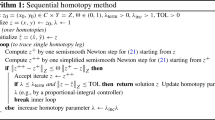Abstract
The continuation method, well-established for the solution of nonlinear equations is extended to restricted optimization problems. Only the locally active restrictions are considered along the homotopy path. It is assumed that there are only finitely many critical points, i. e. that there are only finitely many changes of the index set of active restrictions.
The globally convergent algorithm which we present proceeds in three stages:
-
1.
Within each stability region, the solution is computed by the classical continuation method.
-
2.
On the boundary of a stability region, a critical point\(\bar t\) is determined.
-
3.
A new active index set is determined when\(\bar t\) is passed.
For the class of convex problems, the hypotheses for the convergence of the algorithm may be secured. The algorithm is applied to several examples.
Zusammenfassung
Die Stetigkeitsmethode, die sich bei der Lösung nichtlinearer Gleichungen gut bewährt hat, wird übertragen auf nichtlineare Optimierungsprobleme mit Restriktionen. Entlang des Homotopiepfades werden nur die jeweils aktiven Restriktionen betrachtet. In der Arbeit wird u. a. vorausgesetzt daß nur endlich viele kritische Punkte existieren; d. h. die Indexmenge der aktiven Restriktionen wechselt nur endlich oft.
Der global konvergente Algorithmus, der hier vorgestellt wird, läuft in folgenden drei Stufen ab:
-
1.
Innerhalb der einzelnen Stabilitätsbereiche berechnet man die Lösung mit der klassischen Stetigkeitsmethode.
-
2.
Am Rand eines Stabilitätsbereiches ist ein kritischer Punkt\(\bar t\) zu bestimmen.
-
3.
Bei Überschreitung von\(\bar t\) ist die neue aktive Indexmenge zu berechnen.
Für die Klasse der konvexen Probleme lassen sich die Voraussetzungen für die Konvergenz des Algorithmus nachweisen. Der Algorithmus wird an einigen zum Teil aus der Literatur entnommenen Beispielen getestet.
Similar content being viewed by others
References
Alexander, J. C.: The topological theory of an embedding method. In: Continuation Methods (Wacker Hj., ed.), pp. 37–68. New York: Academic Press 1977.
Avila, J. W.: The feasibility of continuation methods for nonlinear equations. SIAM J. Numer. Anal.11, 102–121 (1974).
Bank, B., Guddat, J., Kummer, B., Klatte, D., Tammer, K.: Nonlinear parametric optimization. Berlin: Akademie-Verlag 1982 (A German version as Seminarbericht Nr. 31 der Sektion Mathematik der Humboldt-Universität zu Berlin.)
Burkhardt, S., Richter, C.: Ein Prädiktor-Korrektor-Verfahren der nichtlinearen Optimierung. Wiss. Zeitschrift der Technischen Universität Dresden (to appear).
Den Heijer, C., Rheinboldt, W. C.: On steplength algorithms for a class of continuation methods. SIAM J. Num. Anal.18, 925–948 (1981).
Fiacco, A. V.: Sensitivity analysis for nonlinear programming using penalty methods. Mathematical programming10, 287–311 (1976).
Fletcher, R.: Practical methods of optimization, Vol. 2: Constrained optimization, pp. 1–224. New York: J. Wiley 1981.
Georg, K.: On tracing an implicitly defined curve by quasi-Newton steps and calculating bifurcation by local perturbations. SIAM. J. Stat. Comp.2, 35–49 (1981).
Gfrerer, H., Guddat, J., Wacker, Hj., Zulehner, W.: Globalization of locally convergent algorithms for nonlinear optimization problems with constraints. To appear in: Semi-Infinite Programming and Applications — an International Symposium, Austin, Texas 1981, Lecture Notes in Economics and Mathematical Systems, pp. 129–138 (May 1983).
Gfrerer, H.: Globalisierung der Multiplikatormethode in der nichtlinearen Optimierung mit Hilfe von Einbettung. Dipl.-Arbeit, Math. Inst., Universität Linz, 1982, pp. 1–100.
Guddat, J., Wacker, Hj., Zulehner, W.: On imbedding and parametric optimization — a concept of a globally convergent algorithm for nonlinear optimization. Institutsbericht Nr. 200, Mathem. Inst. Universität Linz. To appear in: Math. Progr. Stud.1983, 1–33.
Hackl, J., Wacker, Hj., Zulehner, W.: An efficient stepsize control for continuation methods. Bit20, 475–485 (1980).
Hackl, J.: Solution of optimization problems with nonlinear restrictions via continuation methods. In: Continuation methods (Wacker, Hj., ed.), pp. 95–127. New York: Academic Press 1977.
Hestenes, M. R.: Augmentability in optimization theory. JOTA32, 427–440 (1980).
Kojima, M.: Strongly stable stationary solutions in nonlinear programs. In: Analysis and computation of fixed points (Robinson, S. M., ed.), pp. 93–138. New York: Academic Press 1980.
Kojima, M.: A complementary pivoting approach to parametric programming. Math. of Operations Research3, 17–36 (1978).
Kojima, M., Hirabayashi, R.: Continuous deformations of nonlinear programs. Techn. Rep. 101, Dept. of Information Sciences, Tokyo Institute of Technology, pp. 1–84 (1981).
Mangasarian, O. L., Fromovitz, S.: The Fritz John necessary optimality conditions in the presence of equality and inequality constraints. J. Math. Anal. Appl.17, 37–47 (1967).
Richter, C.: Zur globalen Konvergenz des gedämpften Wilson-Verfahrens. Math. Operationsforsch. Statistik. Ser. Optimization10, 213–218 (1979).
Richter, C.: Über die numerische Behandlung von Einbettungsverfahren in der nichtlinearen Optimierung. Preprint, Techn. Univ. Dresden, 1980.
Richter, C.: Über die numerische Behandlung von Optimierungsverfahren mit Hilfe von verallgemeinerten Variationsungleichungen und von Nichtoptimalitätsmaßen. Diss. B, Techn. Univ. Dresden, 1980.
Ritter, K.: Ein Verfahren zur Lösung parameterabhängiger nichtlinearer Maximumprobleme. Unternehmensforschung6, 149–196 (1962).
Robinson, S. M.: A quadratically-convergent algorithm for general nonlinear programming problems. Math. Progr.3, 145–156 (1972).
Robinson, S. M.: Strongly regular generalized equations. Math. of Op. Research5, 43–62 (1980).
Schwetlick, H.: Numerische Lösung nichtlinearer Gleichungen. Berlin: VEB Deutscher Verlag der Wissenschaften 1979.
Tammer, K.: Die Abhängigkeit eines quadratischen Optimierungsproblems von einem Parameter in der Zielfunktion. Math. Operationsforsch. Statistik5, 573–590 (1974).
Tapia, R. A.: Diagonalised multiplier methods and quasi-Newton-methods for constrained optimization. JOTA,22, 135–194 (1977).
Wacker, Hj., ed.: Continuation methods. New York-San Francisco-London: Academic Press 1978.
Watson, T.: Solving the nonlinear complementarity problem by a homotopy method. SIAM J. of Control and Optimization17, 36–46 (1979).
Zangwill, W. I., Garcia, C. B.: Equilibrium programming: The path following approach and dynamics. Math. Progr.21, 262–289 (1981).
Zulehner, W.: Schrittweitensteuerung für Einbettungsmethoden. Diss., Math. Inst., Universität Linz, pp. 1–94, 1981.
Author information
Authors and Affiliations
Additional information
Parts of the work were supported by the Fonds zur Förderung der österr. Forschung.
Rights and permissions
About this article
Cite this article
Gfrerer, H., Guddat, J. & Wacker, H. A globally convergent algorithm based on imbedding and parametric optimization. Computing 30, 225–252 (1983). https://doi.org/10.1007/BF02253895
Received:
Issue Date:
DOI: https://doi.org/10.1007/BF02253895



